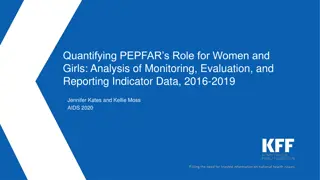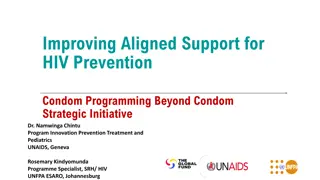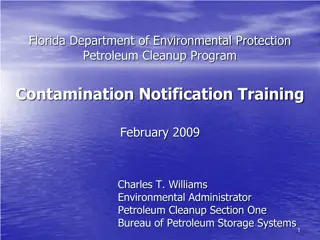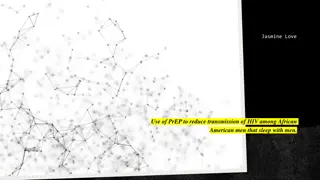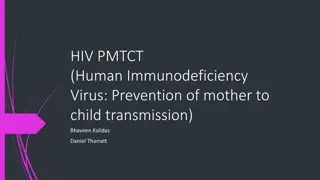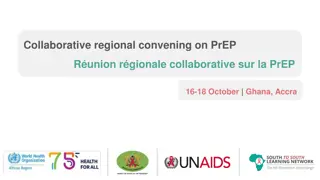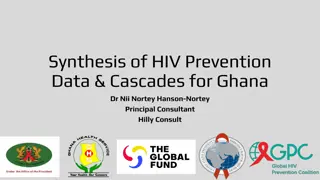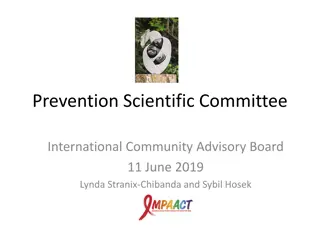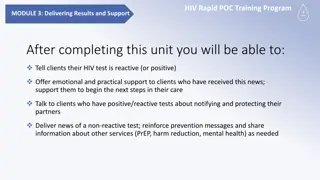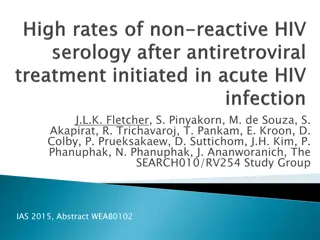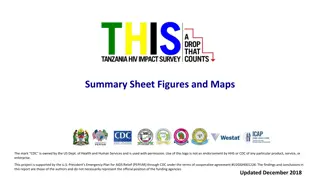PEPFAR's Focus on Partner Notification Services for HIV Prevention
PEPFAR is intensifying efforts on partner notification services for HIV prevention to address the global issue of undiagnosed HIV cases. The initiative aims to improve testing strategies, increase testing volumes, and enhance epidemic control. By reaching HIV testing targets and implementing efficient case-finding strategies like partner testing, PEPFAR seeks to achieve significant progress towards the 2020 and 2030 goals for HIV diagnosis and treatment.
Download Presentation

Please find below an Image/Link to download the presentation.
The content on the website is provided AS IS for your information and personal use only. It may not be sold, licensed, or shared on other websites without obtaining consent from the author. Download presentation by click this link. If you encounter any issues during the download, it is possible that the publisher has removed the file from their server.
E N D
Presentation Transcript
Why PEPFAR Is Going All In on Partner Notification Services Heather Watts MD Director of HIV Prevention, Program Quality Team Office of the Global AIDS Coordinator
In 2018, 79% of people living with HIV knew their status, leaving 8.1 million people undiagnosed 2
Different testing strategies are needed for countries approaching attainment of the first 90, shifting from widespread testing to a focused, public health approach based on epidemiology 3
Increasing testing volumes and decreasing yields are not sustainable and will not get us to epidemic control PEPFAR Supported Testing FY15-FY18 5.0% 100,000,000 4.5% 90,000,000 4.0% 80,000,000 3.5% 70,000,000 3.0% 60,000,000 2.5% 50,000,000 2.0% 40,000,000 1.5% 30,000,000 1.0% 20,000,000 0.5% 10,000,000 0.0% 0 FY15 FY16 FY17 FY18 # tests # + yield 4
Progress toward 2020 and 2030 Reaching HIV testing targets # PLHIV Diagnosed (Millions) Target 2030 95-95-95 Target 2020 90-90-90 40 35 Steep increase: Ramping up the number of facilities, expansion of community based HTS, testing campaigns, geographic prioritization & KP focused strategies (e.g. Social Network Testing Strategy) Getting here has required: 600+ million tests in low- to middle-income countries (2010-14) 380+ million HIV rapid diagnostic tests (RDTs) procured by donors. Between 2012-16 ~ US$ 473 million on HIV RDTs alone 30 25 Initial decelerated increase: Individuals more difficult to reach via traditional strategies 20 15 To achieve 2020 and 2030 targets More targeted testing and linkage to care Scale-up index partner and family testing Routine monitoring of emerging hot spots and changing geography for further prevention and case finding 10 Initial slow start to steep increase In 2005 ~10% PLHIV diagnosed. Increases marked by ramping up PITC (Provider Initiated Testing and Counseling) 5 0 2005 2010 2015 2020 2025 2030 Adapted from V. Wong and A. Medley. PEPFAR Service Delivery Models Call: Finding the Undiagnosed, January 31, 2018, Presentation
Partner Testing: An Effective Case Finding Strategy Several trials have demonstrated that index partner testing can: (1) increase uptake of HTS and (2) identify partners with undiagnosed infection (yield ranges from 35- 62%), with no reports of serious intimate partner violence (IPV).
Cost-effectiveness of Assisted partner notification Example from western Kenya Assisted partner notification Cost per partner tested APS is cost-effective for reducing HIV burden in western Kenya and similar settings. Task-shifting to lay providers will likely increase affordability. Although cost-effective, it should be combined with other HIV testing and prevention approaches Source: Sharma 2017
Benefits of Partner Notification Services Increased efficiency of testing allowing broader treatment coverage Increased identification of asymptomatic children Benefits to couples/partners Mutual support to access HIV prevention, treatment and care Improved adherence and retention on treatment Increased support for PMTCT Prioritization of HIV prevention for serodiscordant couples Condoms ART to reach viral suppression Pre-exposure prophylaxis for uninfected partner until VLS 8
ICT: Promising Practice, Ghion DIC, Bahir Dar MULU: Key Populations 9
Countries with an assisted partner notification or index HIV testing policy (top) and with policy and doing index testing (bottom) of all those reporting, by WHO region, 2017-2018 61% and 70% of countries reporting had an assisted partner notification or index HIV testing policy in 2017 and 2018, respectively 44 50 40% 59% 38 40 32 30 30 61% 72% 79% 68% 71% 94% 30 23 19 18 16 16 20 15 14 10 91% 50% 50% 10 83% 13 12 12 12 11 11 8 8 10 4 4 0 AFR AMR EMR EUR SEAR WPR 2017 # With Policy 2017 Total # Reporting 2018 # With Policy 2018 Total # Reporting 50 41% 53% 43 53% 45 37 40 32 35 30 65% 63% 62% 69% 40% 30 23 25 36% 67% 38% 38% 17 17 20 16 16 15 13 12 12 15 11 11 11 10 8 8 8 8 10 4 3 3 5 0 AFR AMR EMR EUR SEAR WPR 2017 # Implementing w/ Policy 2017 Total # Reporting 2018 # Implementing w/ Policy 2018 Total # Reporting GAM WHO, UNAIDS, UNICEF, 25 June 2019 2017 = 72/118 countries reporting; 2018=91/130 countries reporting
Identification of Children Living with HIV Lags Behind Adults Identification in Many Countries, Leading to Lower Treatment Coverage and VLS Index testing is key to identify children living with HIV 11
Family Index Testing: A high yield strategy to identify healthy children with HIV Several studies show family index testing can increase: 1. the number of children identified at a faster rate 2. the identification of healthy children living with HIV and 3. HIV testing yield [4% Ahmed, 7% Wagner, 12% Tonwe-Gold, 18% Kulzer]
Orphan and Vulnerable Children Programs are an important component of index testing in children and their families 13
HIV case finding approaches supported by PEPFAR (COP19) HIV Case Finding Approaches for COP19 for PEPFAR Support Index Testing through facility or community (sexual and injection drug use contacts and exposed biologic children of newly diagnosed HIV positive individual and those on ART but unsuppressed) Minimum 20% to 40% yield (adults) Figure 9.5.3. COP Guidance ART Coverage: National or subnational TB and STI Testing key populations Other community or mobile PMTCT HIV self- testing Other facility based testing: *Symptom- based *Risk-based *Men over 25yrs 70% or greater Yes Yes No In high burden areas Yes Yes Minimum 10% yield Less than 70% Minimum 20% to 40% yield (adults) Yes Yes Targeted to specific populations and in high disease burden areas Yes Yes 14
Key Considerations for Index Testing in COP19 Intimate Partner Violence (IPV) Risk Assessment is a required component for Index Testing To protect the safety of the index client, partners who pose a risk of IPV should be excluded from PNS, and the index client provided with appropriate care and support services for IPV. Primary goal of the IPV Risk Assessment is to ensure no harm comes to the index client as a result of index testing services Link: Link all positives to treatment and start index testing for their partners/children Link negatives to prevention services: condoms, VMMC, PrEP Use data to monitor implementation of PNS and yield 16
How to Interpret the Cascade for Quality Improvement Other sources of index cases include those with unsuppressed viral load Start: Number of Newly Diagnosed Individuals Large Drop Here Could Suggest Inadequate Personnel Ratio of No. Partners Elicited to No. of Index Clients Reached Should Be 1 Large Drop Off Here Could Indicate HR Issues/Overreliance on Client Referral Yield Should Be 20- 40% for Sex Partners Aim for 90% LTC
Index testing yield is increasing in PEPFAR Number of index tests for all ages and yield over time in PEPFAR 3500000 16.00% 14.00% 3000000 12.00% 2500000 10.00% 2000000 8.00% 1500000 Q1 and Q2 6.00% 1000000 4.00% 500000 2.00% 0 0.00% 2017 2018 2019 index + index total yield 19
The proportion of PLHIV found through index testing is increasing in PEPFAR and we expect continuing increases. Index positives, total positives, and % of positives from index testing, all ages 4000000 14.0% 3500000 12.0% 3000000 10.0% 2500000 8.0% 2000000 Q1 and Q2 6.0% 1500000 4.0% 1000000 2.0% 500000 0 0.0% 2017 2018 2019 index + yield total pos index+/total 20
ADULT INDEX POSITIVITY: large range, but most >10%
Summary and Conclusions New approaches to testing, including index testing, enhanced peer outreach, and hotspot mapping, are needed to find the remaining PLHIV, especially in countries nearing epidemic control. Partner notification services provide: More efficient testing; Better support for treatment adherence in couples; Opportunities for prevention in uninfected partners; The primary mode of identification of asymptomatic children. PNS must be provided according to standard guidelines, including an assessment for IPV and other risks, and those found to be living with HIV must be linked to treatment and negatives to prevetion. Results should be monitored to assure implementation with fidelity. PEPFAR IS ALL IN ON PNS! 23
Thank You! 24




